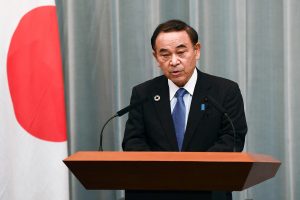Despite wavering vaccine supplies and glaring racial and geographic inequities plaguing Los Angeles County’s rollout, Gov. Gavin Newsom on Monday praised the region’s distribution efforts and touted the city of Long Beach as a model for the rest of the state.
Speaking from a vaccination site at the Long Beach Convention Center, Newsom vowed to press forward with plans to vaccinate educators, reopen schools and refocus on hard-hit communities.
Long Beach, which has its own public health department separate from L.A. County’s, began vaccinating teachers in January and has already announced plans to reopen schools for its youngest students March 29.
“I want to encourage that to be replicated all throughout the state of California,” Newsom said, noting that vaccinating teachers and getting kids back into schools is essential to reopening the economy.
On Friday, he announced that state is setting aside 10% of all first doses it receives for educators and childcare workers.
“We’re moving in that direction with clarity, with determination,” he said.
Currently, the state is averaging just shy of 200,000 doses administered each day and will be close to providing 7.5 million people with at least one dose of the vaccine by the end of Monday, the governor said.
But there is still not enough supply to vaccinate everyone who is eligible. California receives, on average, about 1.3 million doses per week, Newsom said, even though it has the capacity to build out a system that could administer as many as 4 million doses per week.
“Sites all across the state of California are toggling back based upon limited supply,” he said, adding that the Long Beach site is running at about one-third of its capacity. “That’s a manufacturing issue. … It’s simply not what we’re capable of administering, meaning we can do exponentially more.”
Adding to supply concerns were delivery issues caused by inclement weather across the nation. The main manufacturing sites for Moderna and Pfizer-BioNTech are in Massachusetts and Michigan, and at least two scheduled shipments did not make it to L.A. last week. City-run sites that were forced to close amid the delays are slated to reopen Tuesday.
Despite the uneven rollout, Newsom said the state is in a “much better place” as the number of coronavirus cases continues to drop. Case rates plunged from 8% one month ago to 3% on Monday, while hospitalizations and intensive care unit admissions are down 41% and 39%, respectively, over the last two weeks.
In addition to educators, Long Beach also began vaccinating food and grocery store workers last month, along with healthcare workers, firefighters, police officers and “100% of its nursing home residents,” Mayor Robert Garcia said Monday.
Not all parts of the county are running as smoothly. According to The Times’ vaccination tracker, only 12% of L.A. County’s 10 million residents have been vaccinated, and some areas are faring far better than others.
In South Los Angeles and Compton, for example, only 5% of residents have been vaccinated, compared with 25% of residents in Beverly Hills.
Newsom on Monday doubled down on his promise to support efforts that “advance the cause of equity” and “make sure that we are meeting people where they are, including public housing sites.”
“In the aggregate, as a state, we’re not close to where we need to be in terms of meeting our equity targets,” he said. “We need to own that.”
In addition to launching a dashboard to monitor vaccine distribution, the governor said the state also put out grants to more than 100 community-based organizations to advance outreach, education and organization efforts, and to identify sites for pop-up and mobile vaccination operations.
The state also partnered with President Biden’s administration to launch two large-scale vaccination sites that will be run jointly with the Federal Emergency Management Agency, including a site at Cal State Los Angeles, to help reach underserved communities.
There is still much work to be done. According to The Times’ COVID-19 vaccination tracker, less than 14% of California’s roughly 40 million people have received a shot.

















